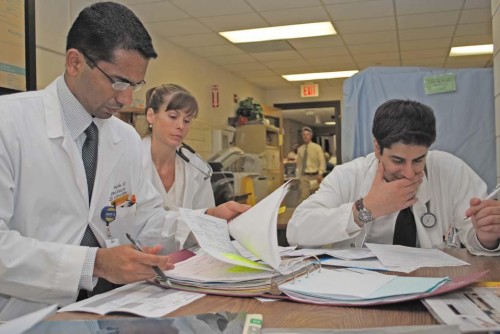April 21
April 21, 2009Lafourche voters to decide three tax renewal issues
April 23, 2009The difference between a medical student and a medical resident comes down to one word: responsibility.
That is what three interns learned quickly when they became the first class of Leonard J. Chabert Medical Center’s Internal Medicine Resident Program last July.
These first-year doctors are now primary care physicians responsible for the health and well-being of very sick, often frightened patients. Theories they studied in medical school have to be turned into diagnosis and treatment.
“Now when you take care of a patient the decisions you make affect that person’s life,” said Dr. Sheny Alex, 30, a first-year intern in the Internal Medicine Resident Program. “Naturally, that accelerates your learning curve dramatically. I’ve also discovered that no matter how much you study medicine, you can’t know everything. You do the best you can and know the right people to find if you need information.”
Alex’s “right people” includes the team of third- and fourth-year medical students doing their rotation in internal medicine under his tutelage and a hospital staff doctor overseeing his work.
The group discusses the progress of Alex’s patients and whether any change in the course of treatment is needed. The staff doctor constantly asks for justification of each action taken, from lab tests performed to medications given and dosages administered.
“The more heads that are on a single patient, the more information we generate,” Alex explained. “If that patient forgets to tell me something is happening to him, there are three other people listening to him. So when we get back together, we have all the information to form a plan of treatment. Once the plan is formed, we make rounds with the staff doctor, and we say, ‘This is what we think should be done.'”
It is that kind of team effort and patient-oriented approach that earned the hospital recognition as a Physician Practice Connections-Patient Centered Medical Home (PPC-PCMH) by the National Committee for Quality Assurance (NCQA) in November.
“This is a new appreciation for the medical home approach to health care where a patient can identify a physician as their primary care provider and the person responsibile for all of the patient’s care,” said Dr. Terry Delord, director of adult ambulatory medicine. “With our approach, the physician coordinates the patient’s care as opposed to leaving it to the patient’s own accord.”
While the range of patient ailments and remedies can vary wildly, Alex’s shift is often quite steady.
His day begins at either 6 or 7 a.m., depending on his patient load. He visits all his patients, seeing if any serious issues need to be addressed from overnight. He receives all the lab work to make sure treatment is heading in the right direction, while the medical students make notes on patients’ progress.
Around 9 a.m., Alex, his students and the staff doctor have their discussion and do rounds.
At 11 a.m. the team has Morning Report, where the on-call team (which admits overnight patients until 7 a.m.) picks one case and presents it for discussion.
A noon conference covers various topics relating to what Alex will need to know to pass the Internal Medicine Board Exam after his residency ends. Either a staff doctor hosts the conference in a classroom or a live feed of different conferences from Ochsner Hospital is viewed.
From 1 to 3 p.m., Alex returns to the floors for rounds with his students. He follows up on suggestions left by the staff doctor and views lab test results.
“Patients that can go home are discharged. Patients that can’t go home, I see what lab work needs to be done, tuck them into bed and sign out to the team on call that evening,” Alex said. “If I’m on call, I stay. If another doctor is on call, I take my list and write that these are my patients. This is what you need to be aware of or follow up on lab work.”
Twice a week, Alex is on call, working a 30-hour stretch from 7 a.m. to 1 p.m. the next day. During that time, he is responsible for all emergency room admissions, floor patients and teams.
“That can be extremely tiring depending on how the night before went,” Alex explained. “Sometimes we get very busy. I usually get about an hour and a half of sleep, but the last time I only got 40 minutes. It was rough.”
“Doing a residency is a maturing process,” Delord insisted. “As you graduate from medical school, you have a lot of the basic science and medical knowledge you need to behave as a physician. But the training process is where you take that knowledge in the classroom and translate it to the patient sitting across from you in the exam room. It’s a humbling experience because you think you know it all, but when you get out there and deal with real patients you have to learn how to make it fit the patients.”
The Numbers Didn’t Add Up
Chabert began the residency program because the hospital projected that the region would experience a shortage of internal medicine doctors in the region.
Dr. Tim Ferguson did a survey of how many internal medicine doctors were in the area, how many would be retiring in the next five years and the number of graduating medical students entering the field.
“The numbers didn’t match up,” said Rhonda Green, Chabert chief executive officer. “Looking at the future of our community, we decided to be proactive and get this program started so we could train our own doctors. It’s a well-known fact (in the medical community) that 75 percent of doctors who train in an area stay in that area.”
Chabert’s internal medicine residency is only the seventh program approved in the United States in the last 10 years, according to Green.
Three residents entered the program last year, eight more will enter in July, and by July 2010 the hospital will be at full capacity, training 24 residents.
Residents from Ochsner and LSU will still do their internal medicine clinical rotation at Chabert, but the residents in the program belong specifically to the hospital.
The program has so far been spared in Gov. Bobby Jindal’s proposed budget cuts to the LSU Health System. However, Chabert is still scheduled to take the second biggest cut in the seven-hospital system at $3.9 million.
“The LSU system realizes that things like the doctor training program are not only important to the community, they’re important to the state,” Green said. “We may have to cut back on other services. We may lose our dental clinic, but the overall outcome is going to be good for our hospital. We can see more patients and generate more revenue.”
There are Limits on What You Can Do
As Alex nears the end of his first year of internal medicine residency, the program has been everything he imagined. He said he has learned things that were never taught in medical school.
The field is challenging and satisfies his intellectual curiosity. The doctors and nurses have been tolerant in sharing their knowledge with him. Patients and their families are appreciative and kind with their words and actions.
“The staff is great. They are understanding. Everybody works well together,” Alex said. “The patients are wonderful too because they are grateful for what you are doing for them. It makes for a tremendous working environment.”
It is patients like Carol Crowell, who looked so ill when she was admitted, Alex said, “I was considering calling a priest.”
But after fighting an infection for two weeks, she is strong and ready to be discharged.
“There’s my dream team,” she exclaimed as Alex and his students entered her room. “I love them and everything they’ve done. I wouldn’t have came through without them.”
Sometimes, even exhausting all medical options is not enough.
One of Alex’s elderly patients is suffering from deep depression after her husband and brother recently died. After weeks in the hospital, she still refuses to swallow any food. He can’t force her to eat, and her family will not take her in for full-time care. So he must discharge her and hope for the best.
“If a patient is of sound mind, it’s up to them to decide their treatment,” Alex explained. “We’ve tried other ways of getting food into her stomach. We usually insert a tube into the stomach, but she’s not a good candidate for surgery. I’m going to give her something to stimulate her appetite. If that doesn’t work, and she has lost the will to live, the only thing I can do is send her home with hospice care.”
One patient, a homeless man, has late stage prostate cancer that is spreading. He was in a private hospital outside of Terrebonne Parish, but got dumped into the LSU Health System.
“We get them all the time. As soon as they come in the door, it’s a wallet biopsy, and if they don’t meet the wallet biopsy criteria, they’re off to one of the LSU hospitals,” Alex said.
“There are limits on what you can do. He needs a couple of strong, expensive medications, but he can’t afford that,” he added. “We have to be concerned that he’s homeless. Is he ever going to come back? He’s probably going to come back one day in big septic shock because he has no other hope, and he’s going to die immediately. We’ll keep him here a couple of days, take out his testes, and discharge him hoping he comes back. It’s sad.”
Despite such cases, Alex remains committed to working in the public health system. He wants to eventually work in the intensive care unit, serving the most severely injured patients.
However, he has to survive the next two years in residency.
“When I talk to some people who have been working here for a very long time, they have seemed to accept the reality of the situation that there are some patients that can’t be saved,” Alex said. “I guess I’m still starting out and naïve, but I’m very optimistic.”
Dr. Sheny Alex (left), a first-year resident in Chabert Medical Center’s Internal Medicine Resident program, goes through a patient’s medical record along with third-year medical student Rebecca Muttart (center) and fourth-year medical student Kabeer Burman. * Photo by KEYON K. JEFF














